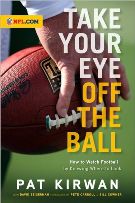All Faculty Excerpts
Take Your Eye Off The Ball
 Perhaps you love football, can’t get enough of it. Perhaps you’re just starting out with football and want to learn more. Or perhaps you have no interest in football whatsoever. If you’re in the last group, just skip over this, but the other two groups should know about a new book, Take Your Eye off the Ball: How to Watch Football By Knowing Where to Look. The book is written by Gotham teacher David Seigerman and Pat Kirwan, an NFL analyst and former coach. At long last, you can learn what’s really behind all those clashes and passes and slams.
Perhaps you love football, can’t get enough of it. Perhaps you’re just starting out with football and want to learn more. Or perhaps you have no interest in football whatsoever. If you’re in the last group, just skip over this, but the other two groups should know about a new book, Take Your Eye off the Ball: How to Watch Football By Knowing Where to Look. The book is written by Gotham teacher David Seigerman and Pat Kirwan, an NFL analyst and former coach. At long last, you can learn what’s really behind all those clashes and passes and slams.Here’s a play from the first chapter:
___________________________________
When a baseball fan goes to a ballgame, among the first things he often does is grab a hot dog, a beer and a program before heading to his seat. Then he flips open the program and fills in the two starting lineups with his little golf pencil.
Already, there’s a fundamental difference in the fan experience between baseball and football. The first pitch hasn’t even been thrown and the baseball fan has had more of an interactive opportunity than the football fan will enjoy all day. There may be no crying in baseball, but there’s no scorecard in football.
Until now.
Before we get to examining strategy and positional nuances and how off-the-field and off-season considerations shape the way games will unfold on NFL Sundays, let’s start with an easy first step, a simple way to connect football fans to their game the way baseball fans connect to theirs. If you want to follow football like a coach up in the box, learn to chart a game—football’s version of keeping score.
Just like a baseball fan diligently tracks each at-bat and records every 6-4-3 double play, you can compile the same data that coaches use to make decisions in their play-calling and begin to see trends emerge as a game evolves. You can track specific information for each play—the down and distance, the personnel on the field, and the result. And that running play-by-play will show you how the situation dictates the action and gives you a glimpse into how coaches are approaching a particular game, which will enable you to achieve a level of football sophistication that has been off-limits to too many fans through the years.
Football, like baseball, is about forecasting. Coaches build their entire game plans around tendencies—what their opponent’s track record suggests they might do in a certain situation. A baseball fan can look at a particular game situation—runners on first and second with one out—and predict what an infielder will do if a groundball is hit to him. Football provides the same opportunity to anticipate the action, and the empowerment of the fan begins with understanding the personnel in the game. It’s not enough to know the fundamental concept that there are 11 players on each side of the ball; the composition of that 11-man unit will provide clues for what to expect on any given play.
On offense, there are five linemen and a quarterback on every play—with the exception of the Wildcat or derivatives of it, which we’ll get to later—leaving five interchangeable offensive pieces. Personnel groups are identified by the number of running backs and tight ends on the field on a given play, in that order. If a team sends out two running backs and one tight end, it’s called 21 personnel. If it sends out one back and two tight ends, it’s 12 personnel. In both cases, there will be two receivers on the field. The first indicator a defense looks for is the personnel package the offense is sending out. It should be the first thing you’re looking for, too.
That’s because personnel tips off strategy. If the 22 personnel is on the field—two running backs and two tight ends—it means there’s only one receiver out there. Immediately, you can make an educated guess about what play a coach is likely to call—in this case, probably a run. You can make your prediction even before they break the huddle once you’ve noted who’s in the game.
___________________________________
Reprinted by permission of Triumph Books. Click here to find Take Your Eye Off the Ball at bn.com.
